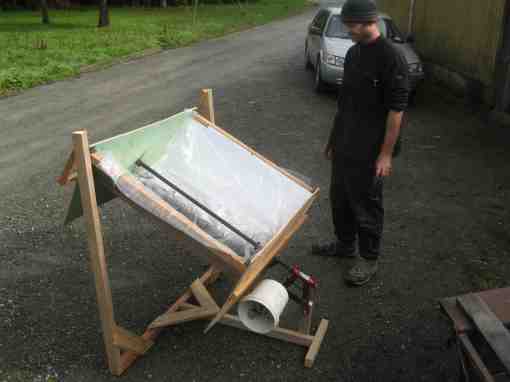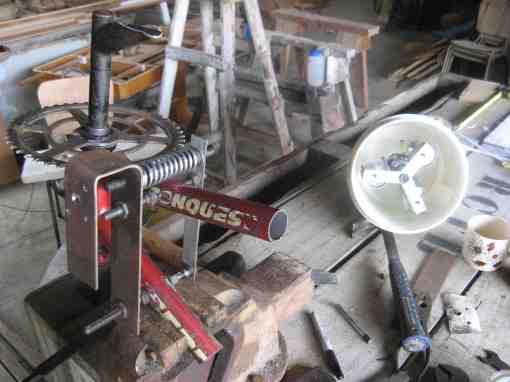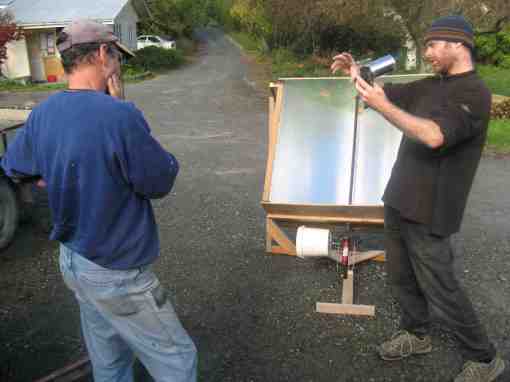“It’s hard to make things that don’t already exist,” Daniel Connell, the 32 year-old inventor of the SolarFlower told me one day as we were building the third ever prototype of his device, “It’ll be a while before I want to do it again.” He’s spent last two years developing this home-makeable parabolic solar energy collector from scrap materials in order to revolutionize energy production in the developing world.
Daniel is a professional 3D animator who normally works five or six weeks per year, though for the last two years he has chosen not to have a job. During this ample free time, he travels the world pursuing personal projects. This allows him plenty of time to invent things that don’t yet exist. The elegant functionality of his device is so brilliant in its simplicity that it’s hard to imagine it is the product of a long difficult design process.
However, his toil hasn’t been in vain. In the process of making the SolarFlower, he has invented possibly the world’s simplest to construct heat engine, possibly the world’s most efficient water wheel, and a solar trough collector that is one of the easiest and cheapest to build in the world. All of this using things like an old bicycle, discarded aluminum sheets used to print newspapers, and energy drink cans. “A bicycle’s like a buffalo,” he says, “you can use every part.”
The key innovation is to automatically track the sun without the use of electronics or clockwork, through a simple mechanism that uses the sun to boil a small amount of ethanol and produce motion. This is constructed from materials such as a peanut butter jar, some bike parts, and aluminum foil.

wheel made from energy drink cans which turn the main collector when heated ethanol cycles through them
The SolarFlower collects sunlight in a parabolic trough, focusing it on a central fixed black copper pipe, heating a liquid which could be water or oil. This energy can then can be used for anything from water heating and purification, electrical generation, cooking, bio-char, heating, gasification, and so forth. Here is Daniel giving a basic rundown of how it works:
You can watch a time-lapse video of the SolarFlower tracking the sun here:
The device is open-source, which means opening up the design process from one of privacy for the purpose of profit to openness for the purpose of global collaborative innovation. The full 3D design and detailed instructions are available for free to everyone.
Daniel says he accepts that no matter how simple the device, ninety-nine percent of people will likely not be willing or able to build one. But if one in every hundred produces enough for a hundred people, then that’s everyone. He encourages the development of small-scale manufacturing and installation companies to spread the device.
The SolarFlower, along with the open source design approach and deployment it represents, marks the emergence of a new type of technology with a pioneering spirit of independence. The focus is on devices that can be built by normal people and employed in their lives now to achieve decentralization and resilience in the way that things are made and done. It is a perfect manifestation of an emerging movement called Open Source Ecology.
The guys at Open Source Ecology are working to develop an entire array of devices like Daniel’s – not just renewable energy producing devices, but also tractors, steam engines, sawmills, laser cutters, and 46 other home-makeable machines designed to re-make civilization according to an open-source, decentralized, sustainable model.
This “Global Village Construction Set” can be seen as a life-size Lego-like building kit of “modular tools that can create entire economies, whether in rural Missouri, where the project was founded, in urban redevelopment, or in the heart of Africa.” Of course, the approach is much the same as the SolarFlower: open-source, low-cost, do-it-yourself, closed-loop manufacturing using scrap materials, distributed economics, and more (read the OSE crash course.)
Daniel and the Open Source Ecology guys are prime examples of what might be called “bioneers,” people who are among the first to research and develop truly sustainable solutions to our global problems. The Bioneers conference is a yearly gathering of such people – it’s similar to the popular TED talks, but purely for social and environmental sustainability innovators.
However, we can’t rely exclusively on bioneering people like Daniel and OSE – it’s a big world with lots of solution building and spreading to do. As the Bioneers conference organizers point out, “Today’s challenges are so huge and complex that they require collaboration and cooperation on large scales.” Open-source approaches to sustainability like SolarFlower and OSE are about intelligently doing the work of world-changing together as a world. That means stepping up and contributing your piece, whatever your skills, talents, and passions might be.
The point is this: we don’t have to wait for corporations to design the solutions we need and sell them to us at high cost; we don’t have to petition the government to do something about changing our energy sources. These institutions are too large, too slow, and too caught up in playing their own games to be able to achieve the changes that need to happen.
The most powerful institutions of our time are missing in action, but we don’t need them anyway. We can be the designers and implementers of a new world, solving the greatest problems of our time for ourselves right now. We can show them the way forward: “when the people lead, the leaders follow.”
There are many ways to be a part of the movement for real solutions:
1) Spread the word about SolarFlower and Open Source Ecology by emailing, Facebooking, Twittering, etc.
2) Contribute financially to the movement, as both rely on what is called “crowd funding” or funding in small amounts by many people in order to do their work.
- SolarFlower technology is just starting to break; Daniel will tour the device around Europe starting in mid-June, followed by a world tour through Asia, the Pacific, and South America. Consider helping to kick off his work here: http://www.indiegogo.com/The-SolarFlower-World-Tour-Europe
- Open Source Ecology is supported primarily by its “TrueFans,” people who are essentially patrons of their work and allow its continuing development. They will also be kicking off crowd funding projects on Kickstarter this June to help meet their 2-year goal of developing all 50 Global Village machines by 2012 with $2.4 million.
3) Contribute your skills and expertise to the open source design of these devices. If you see a design flaw in the machine or have an idea of how it could be better, contribute to the forums. The online communities are crucial to the development and continual innovation of these mechanisms.
4) Build and install SolarFlower and the OSE machines for yourself and others! Not only will you be more self-sufficient, but you could make some money in the process if you wanted.
5) OSE has a comprehensive list of how to get involved.
6) Make your own world-changing solutions and share them widely with others!






